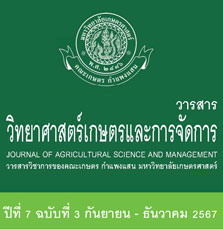Effects of Chemical Fertilizer Formulas on Growth of Outdoor Grown Cannabis (Cannabis sativa L.)
Keywords:
cannabis, nutrient management, chemical fertilizerAbstract
Plant nutrition management is a major factor affecting plant growth and yield. In Thailand, the research lacks information on the nutrient of cannabis. This experiment aimed to observe the effect of chemical fertilizer formulas and rates on growth of outdoor grown cannabis. The experimental design was a Completely Randomized Design with 5 replications, the 4 treatments consist of 1) chemical fertilizer formula 15.8-11.8-19.0 2) chemical fertilizer formula 2-1-4 during the vegetative stage and 2-4-4 during the flowering stage, 3) chemical fertilizer formula 15-15-15 during the vegetative stage and 8-24-24 during the flowering stage and 4) chemical fertilizer formula 30-10-10 during the vegetative and 10-20-30 during the flowering. The fertilizer solution was applied with irrigation every 3 days and the fertilizer formula was changed after 6 weeks of transplanting. The results showed that at 8 weeks after transplanting, treatment 1, application of chemical fertilizer formula 15.8-11.8-19.0 and treatment 4, application of chemical fertilizer formula 30-10-10 during the vegetative and 10-20-30 during the flowering significantly increased plant height, number of leaves per plant and leaf greenness compared to other treatments. For biomass yield including fresh and dry weight of root, stem and branch, and leaves at harvesting, we found that application of chemical fertilizer formula 30-10-10 during the vegetative stage and 10-20-30 during the flowering stage showed the highest total fresh and dry weight of 1.65 and 0.46 kg/plant, respectively. We concluded that the chemical fertilizer formula of 30-10-10 during the vegetative stage and 10-20-30 during the flowering stage was the optimum formula of outdoor grown cannabis
References
กรมวิชาการเกษตร. 2563. การจัดการธาตุอาหารและการให้ปุ๋ยทุเรียน. (ระบบอนไลน์). แหล่งข้อมูล: https://www.doa.go.th/share/attachment.php?aid=2975 (3 กันยายน 2566).
กรมวิชาการเกษตร. 2564. คู่มือสำหรับเกษตรกร การผลิตพืชสกุลกัญชา (Cannabis sativa L.) เพื่อประโยชน์ทางการแพทย์และอุตสาหกรรม. (ระบบอนไลน์). แหล่งข้อมูล: https://www.doa.go.th/th/?p=30917 (25 มีนาคม 2566).
กษิตดิ์เดช อ่อนศรี, กัญตนา หลอดทองหลาง, เกศินี ศรีปฐมกุล และอรพรรณ หัสรังค์. 2565. อิทธิพลของปุ๋ยไนโตรเจนโพแทสเซียม และฟอสฟอรัส ต่อการเจริญเติบโตของกัญชา. วารสารวิทยาศาสตร์ วิศวกรรมศาสตร์ และเทคโนโลยี 1(2): 104-117.
จีราภรณ์ อินทสาร. 2557. ธาตุอาหารพืช. (ระบบออนไลน์). แหล่งข้อมูล: https:// goo.gl/RdNOXp (3 กันยายน 2566).
ธานี ศรีวงศ์ชัย, สุตเขตต์ นาคะเสถียร, อรวรรณ คำดี, อมรรัตน์ ม้ายอง, นฤพนธ์ น้อยประสาร และวีรพงษ์ วิสูตร. 2564. คู่มือการผลิตกัญชา/กัญชงในระบบปิด. คณะเกษตร มหาวิทยาลัยเกษตรศาสตร์. กรุงเทพฯ. 120 หน้า.
ปุญญิศา ตระกูลยิ่งเจริญ. 2564. โพแทสเซียมกับการเจริญของพืช. วารสารดินและปุ๋ย 43(1): 10-27.
ปุญญิศา ตระกูลยิ่งเจริญ. 2566. ผลของปริมาณธาตุไนโตรเจนต่อผลผลิตและปริมาณสารพฤกษเคมีในฟ้าทะลายโจรที่ปลูกในดินทราย. วารสารผลิตกรรมการเกษตร 5(2):30-38.
พราว ศุภจริยาวัตร, ศรายุธ ระดาพงษ์, ตีญานี สาหัด, ณฐภัทร หาญกิจ, กัญชริญา ภารเขจร, ปฏิภาณ พริ้มพราย, พิเชฐ บัญญัติ, ศิริวรรณ ชัยสมบูรณ์พันธ์, ณัฐพงษ วิชัย และพรชัย สินเจริญโภไคย. 2564. การศึกษาความเป็นพิษของสารสกัดกัญชาพันธุ์ไทยต่อเซลล์เพาะเลี้ยงปกติ. วารสารกรมวิทยาศาสตร์การแพทย์ 63(3): 478-489.
แพทย์สภา. 2562. คำแนะนำสำหรับแพทย์ การใช้กัญชาทางการแพทย์. (ระบบออนไลน์).แหล่งข้อมูล: https://tmc.or.th/pdf/fact/guideline_cannabis_101062.pdf (10 มีนาคม 2566).
ภาษิตา ทุ่นศิริ, ทวีศักดิ์ วิยะชัย, ณัฐกานต์ สีสะอาด, นันทิดา แพงศรี, อนนท์ จันทร์เกตุ และสุภาวดี แก้วระหัน. 2564. ผลของการใช้ปุ๋ยเคมีในอัตราที่แตกต่างกันต่อการเจริญเติบโตและผลผลิตของถั่วเหลืองฝักสดกลิ่นหอม พันธุ์เชียงใหม่ 84-2. หน้า 23-29 ใน: การประชุมวิชาการระดับชาติ มอบ. วิจัย ครั้งที่ 16. มหาวิทยาลัยอุบลราชธานี, อุบลราชธานี.
ยงยุทธ โอสถสภา. 2558. ธาตุอาหารพืช. สำนักพิมพ์มหาวิทยาลัยเกษตรศาสตร์. กรุงเทพฯ. 548 หน้า.
วันเพ็ญ โลหะเจริญ, ศีลวัต พัฒโนดม, ปราณี เกียรติประทับใจ, วีรดา ธงงาม, อิทธิสุนทร นันทกิจ, โสระยา ร่วมรังษี และจุฑามาส คุ้มชัย. 2557. ผลของการขาดธาตุอาหารต่อการเจริญเติบโตและความเข้มข้นของธาตุอาหารในใบพริกหวาน. วารสารเกษตร 30(1): 39-48.
สมบุญ เตชะภิญญาวัฒน์. 2538. สรีรวิทยาของพืช. ภาควิชาพฤกษศาสตร์ คณะวิทยาศาสตร์ มหาวิทยาลัยเกษตรศาสตร์, กรุงเทพฯ. 213 หน้า.
สรเพชร มาสุด, ธนวัฒน์ ทองจีน, กรวิชญ์ สมคิด, ภาณุวิชญ์ พูลทรัพย์, ปภาวดี สุฉันทบุตร, กชพร โชติมโนธรรม, ทิพวรรณ ปรักมานนท์, ราตรี พระนคร, วรรณวิภา พินธะ, พิเชฐ บัญญัติ, และศิริวรรณ ชัยสมบูรณ์พันธ์. 2564. ปริมาณสารแคนนาบินอยด์ในระยะการเจริญเติบโตที่แตกต่างกันของใบกัญชาพันธุ์ไทย. วารสารกรมวิทยาศาสตร์การแพทย์ 63(3): 524-540.
สังคม เตชะวงค์เสถียร. 2558. การเจริญเติบโตและพัฒนาการของพืช. เอกสารวิชาการ. สาขาพืชสวน ภาควิชาพืชศาสตร์และทรัพยากรการเกษตร คณะเกษตรศาสตร์ มหาวิทยาลัยขอนแก่น, ขอนแก่น. 60 หน้า.
สิริญา มิตรศรัทธา. 2562. จากใบสดสู่น้ำกัญชาหรือ Cannabis Juice ที่กำลังเป็นเทรนด์ใหม่สำหรับคนรักสุขภาพ. (ระบบออนไลน์). แหล่งข้อมูล: https://www.cannhealth.org/content/6700/cannhealth (6 มีนาคม 2566).
หนึ่ง เตียอำรุง, นันทกร บุญเกิด และพรรณลดา ติตตะบุตร. 2564. การผลิตและการใช้ประโยชน์จากกัญชา. เอกสารวิชาการ.มหาวิทยาลัยเทคโนโลยีสุรนารี, นครราชสีมา. 60 หน้า.
อิทธิสุนทร นันทกิจ. 2558. จะเพิ่มประสิทธิภาพการผลิตพืชแบบไม่ใช้ดินทางการค้าได้อย่างไร. วารสารดินและปุ๋ย 37(1-4): 40-48.
A.O.A.C. 1990. Official Method of Analysis of AOAC International. 15th ed., A.O.A.C. International, Arlington, Virginia, U.S.A. 770 p.
Altland, J.E., C.H. Gilliam, G.J. Keever, J.H. Edwards, J.L. Sibley and D.C. Fare. 2003. Rapid determination of nitrogen status in pansy. HortScience 38: 537-541.
Anderson, S.L.I, B. Pearson, R. Kjelgren and Z. Brym. 2021. Response of essential oil hemp (Cannabis sativa L.) growth, biomass, and cannabinoid profiles to varying fertigation rates. Plos One (16)7: 1-16.
Avia, S. and N. Bernstein. 2020. Response of medical cannabis (Cannabis sativa L.) to nitrogen supply under long photoperiod. Frontiers in Plant Science 11:1-15.
Bremner, J.M. and M.A. Tabatabai, 1972. Use of an ammonia electrode for determination of ammonia in Kjeldahl analysis of soil. Communication Soil Science and Plant Analysis 3(2): 159-165.
Evans, J.R. 1989. Photosynthesis and nitrogen relationships in leaves of C3 plants. Oecologia 78(1): 9-19.
Gahoonia, T.S. and N.E. Nielsen. 2003. Phosphorus (P) uptake and growth of a root hairless barley mutant (bald root barley, brb) and wild type in low- and high-P soils. Plant Cell and Environment 26: 1759-1766.
Jifon, J.L., J.P. Syvertsen and E. Whaley. 2005. Growth environment and leaf anatomy affect nondestructive estimates of chlorophyll and nitrogen in Citrus sp. leaves. American Society for Horticultural Science 130: 152-158.
Lewys, B., M. Jones and Y. Zheng. 2021. Optimization of nitrogen, phosphorus, and potassium for soilless production of Cannabis sativa in the flowering stage using response surface analysis. Frontiers in Plant Science 12: 1-10.
Panayiota, P., I. Kakabouki and I. Travlos. 2018. Effect of nitrogen fertilization on growth and yield of industrial hemp (Cannabis sativa L.). Notulae Botanicae Hortri Agrobotanici Cluj-Napoca 46(1): 197-201.
Yang, Y., W. Zha, K. Tang, G. Deng, G. Du and F. Liu. 2021. Effect of nitrogen supply on growth and nitrogen utilization in Hemp (Cannabis sativa L.). (Online): Available Source: https://www.mdpi.com/2073-4395/11/11/2310 (April 3, 2023).






